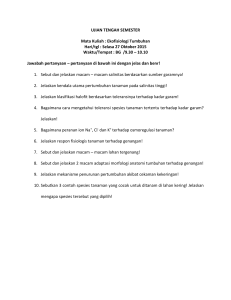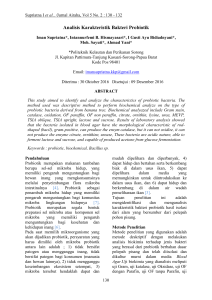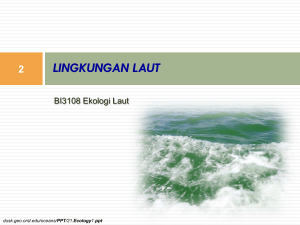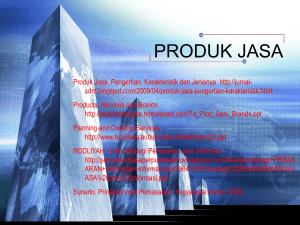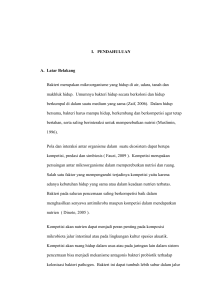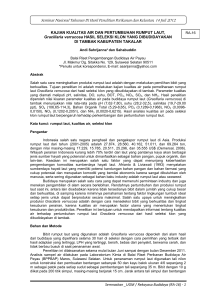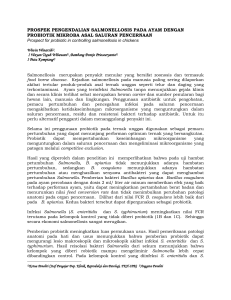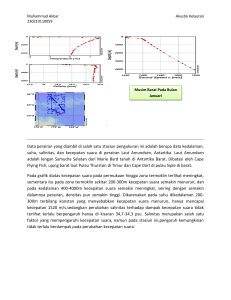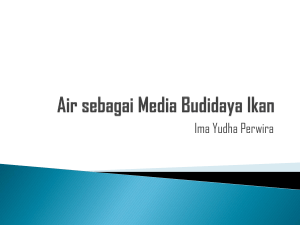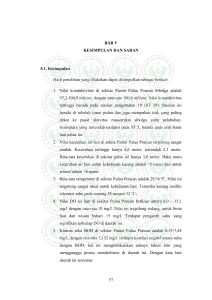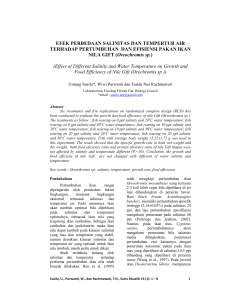ADLN – PERPUSTAKAAN UNIVERSITAS AIRLANGGA v SKRIPSI
advertisement
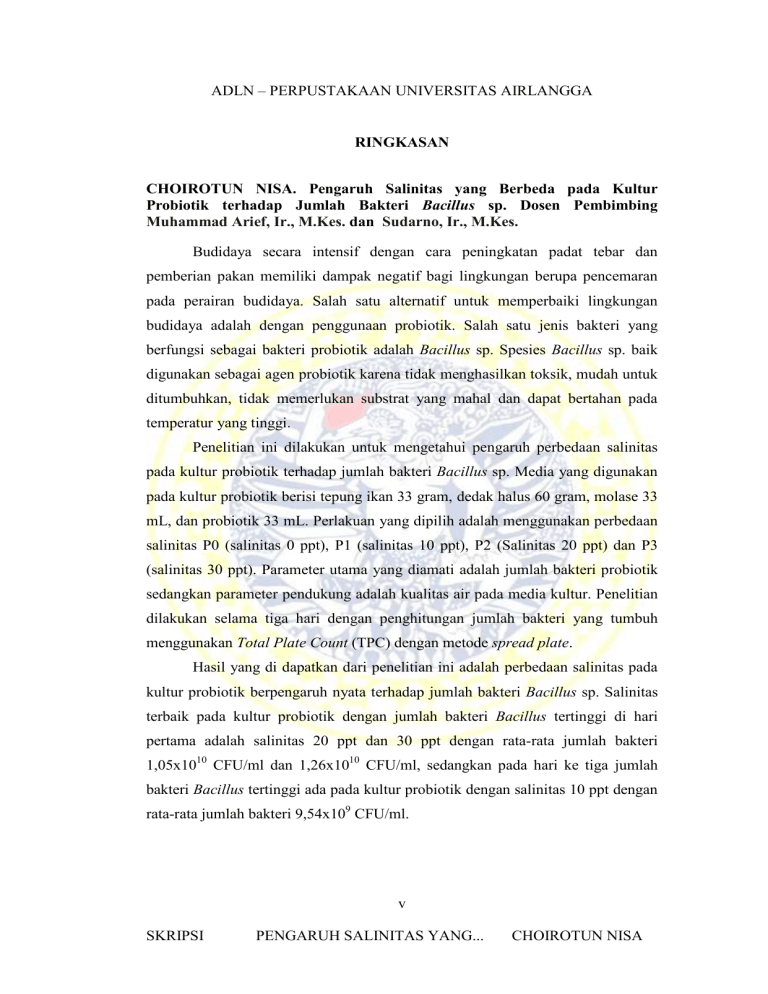
ADLN – PERPUSTAKAAN UNIVERSITAS AIRLANGGA RINGKASAN CHOIROTUN NISA. Pengaruh Salinitas yang Berbeda pada Kultur Probiotik terhadap Jumlah Bakteri Bacillus sp. Dosen Pembimbing Muhammad Arief, Ir., M.Kes. dan Sudarno, Ir., M.Kes. Budidaya secara intensif dengan cara peningkatan padat tebar dan pemberian pakan memiliki dampak negatif bagi lingkungan berupa pencemaran pada perairan budidaya. Salah satu alternatif untuk memperbaiki lingkungan budidaya adalah dengan penggunaan probiotik. Salah satu jenis bakteri yang berfungsi sebagai bakteri probiotik adalah Bacillus sp. Spesies Bacillus sp. baik digunakan sebagai agen probiotik karena tidak menghasilkan toksik, mudah untuk ditumbuhkan, tidak memerlukan substrat yang mahal dan dapat bertahan pada temperatur yang tinggi. Penelitian ini dilakukan untuk mengetahui pengaruh perbedaan salinitas pada kultur probiotik terhadap jumlah bakteri Bacillus sp. Media yang digunakan pada kultur probiotik berisi tepung ikan 33 gram, dedak halus 60 gram, molase 33 mL, dan probiotik 33 mL. Perlakuan yang dipilih adalah menggunakan perbedaan salinitas P0 (salinitas 0 ppt), P1 (salinitas 10 ppt), P2 (Salinitas 20 ppt) dan P3 (salinitas 30 ppt). Parameter utama yang diamati adalah jumlah bakteri probiotik sedangkan parameter pendukung adalah kualitas air pada media kultur. Penelitian dilakukan selama tiga hari dengan penghitungan jumlah bakteri yang tumbuh menggunakan Total Plate Count (TPC) dengan metode spread plate. Hasil yang di dapatkan dari penelitian ini adalah perbedaan salinitas pada kultur probiotik berpengaruh nyata terhadap jumlah bakteri Bacillus sp. Salinitas terbaik pada kultur probiotik dengan jumlah bakteri Bacillus tertinggi di hari pertama adalah salinitas 20 ppt dan 30 ppt dengan rata-rata jumlah bakteri 1,05x1010 CFU/ml dan 1,26x1010 CFU/ml, sedangkan pada hari ke tiga jumlah bakteri Bacillus tertinggi ada pada kultur probiotik dengan salinitas 10 ppt dengan rata-rata jumlah bakteri 9,54x109 CFU/ml. v SKRIPSI PENGARUH SALINITAS YANG... CHOIROTUN NISA ADLN – PERPUSTAKAAN UNIVERSITAS AIRLANGGA SUMMARY CHOIROTUN NISA. Different Salinity Effect on Probiotics Culture Toward to the Baccilus sp.Total Bacteria. Academic advisor Muhammad Arief, Ir., M.Kes. and Soedarno, Ir., M.Kes. Intensive cultivation by increasing stocking density and feeding have a negative impact on the environment as a pollution on aquatic cultivation. One alternative to improve the cultivation environment is the use of probiotics. One type of bacteria that function as probiotic bacteria is Bacillus sp. Species of Bacillus sp. uses as a probiotic agent because it does not produce toxic, easy to grown, does not require an expensive substrate and can stand high temperatures. This research was conducted to determine the effect of different salinity on probiotics culture toward to the Bacillus sp. total bacteria.. Medium used in probiotic cultures containing 33 g fish flour, 60 g soft brand, molasses 33 ml and probiotics 33 ml. This study consists of four treatment used different salinity which are P0 (salinity of 0 ppt), P1 (salinity of 10 ppt), P2 (salinity of 20 ppt) and P3 (salinity of 30 ppt). Research method used experimental test with Completely Randomized Design. The main parameters measured were the number of probiotic bacteria while supporting parameter is the quality of water in the culture medium. The study was conducted over three days by counting the number of bacteria that grow using Total Plate Count (TPC) with a spread plate method. The results showed that the different salinity on probiotics culture significant effect on the number of total bacteria Bacillus sp. The best salinity in probiotics culture with the highest total bacteria Bacillus in the first day is salinity of 20 ppt and 30 ppt with the average number of bacteria 1.05x1010 CFU/ml dan 1.26x1010 CFU/ml, while on the third day the highest total bacteria Bacillus on probiotics culture is salinity of 10 ppt with the average number of bacteria 9.54x109 CFU/ml. vi SKRIPSI PENGARUH SALINITAS YANG... CHOIROTUN NISA
